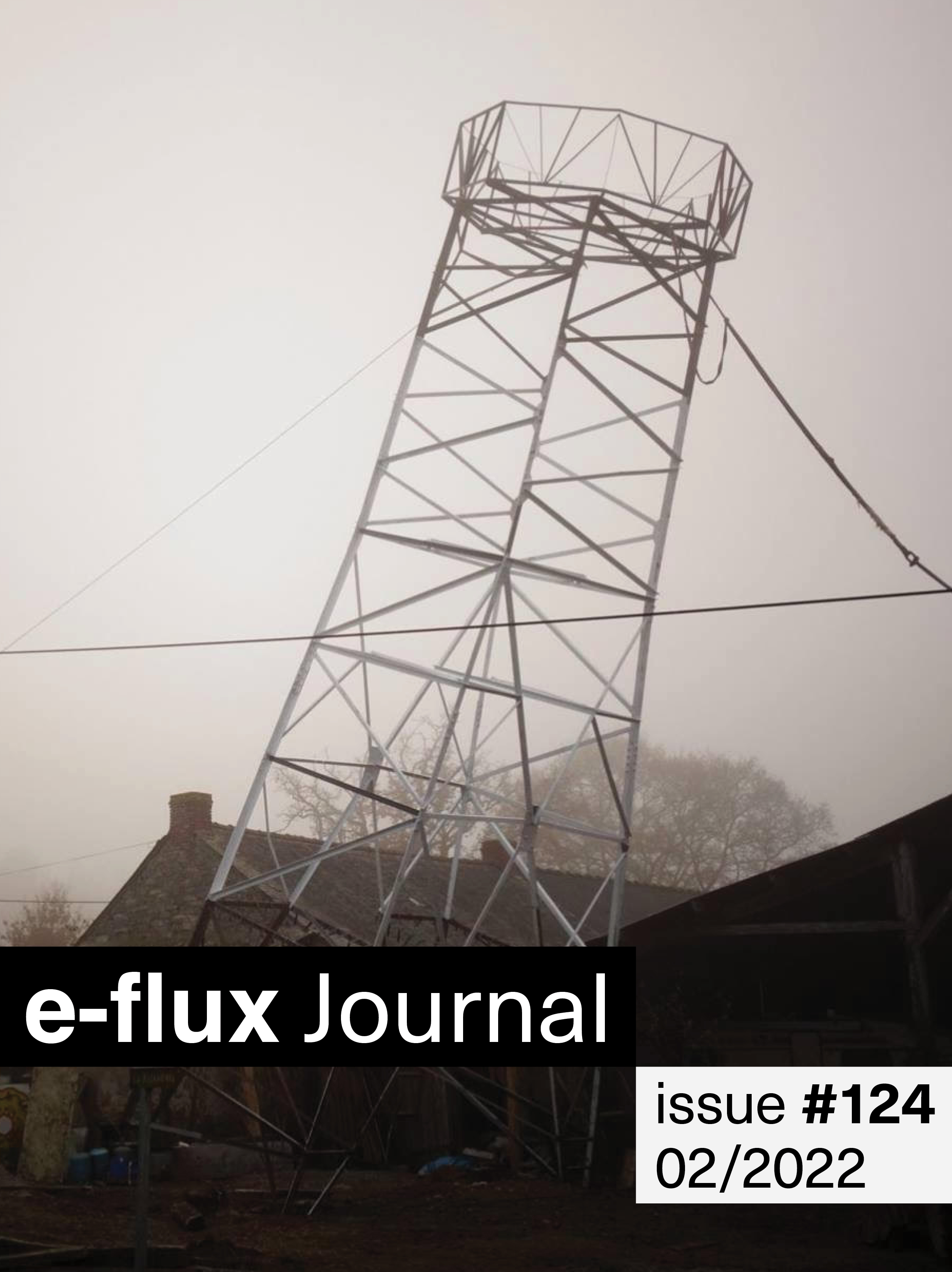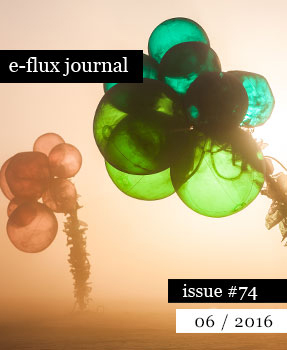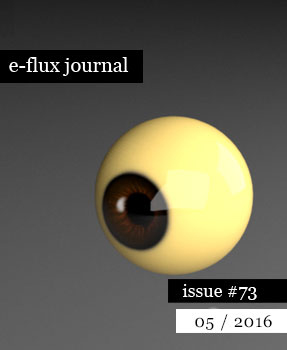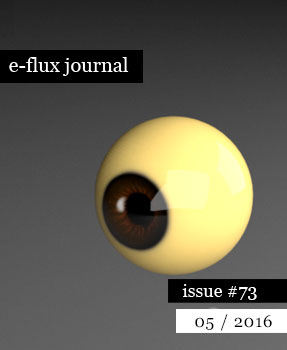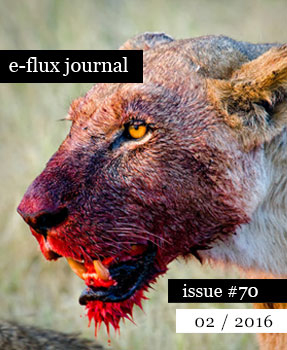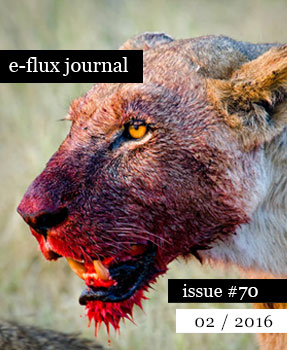e-flux journal issue 124
with Yuk Hui and Brian Kuan Wood, Stanley Wolukau-Wanambwa, Skye Arundhati Thomas, Boris Groys, Order of Sophianic Marxists, Isabelle Fremeaux and Jay Jordan, and Franco “Bifo” Berardi
In the first e-flux journal issue of 2022, Bifo points out a recent social protest movement in China known as tangping (“lying flat”), in which young people increasingly opt out of the pressure to overwork by taking low-paying jobs or not working at all. In the US, “the Great Resignation” has been the name for four and a half million American workers who left their jobs at the end of 2020. But Bifo reminds us that “resignation” also means re-signification—a new meaning given to pleasure, richness, activity, and cooperation that may unveil a previously hidden egalitarian and frugal sensitivity following the exhaustion of the Western geopolitical order.
“ZAD” means zone à défendre (zone to defend); two of our writers report from the ZAD in Notre-Dame-des-Landes, an enormous territory that farmers and people from around France have squatted for over a decade to halt construction of an airport. With chainsaws and horse-hauled logs, nearby inhabitants survey the woods and decide which trees to fell, which to leave standing, and what projects their trunks and branches will comprise, as the art of communal defense and living becomes a sustained reality, with the woods as a comrade.
“What is the risk I pose?” asks the Indian anti-CAA/NRC activist Umar Khalid in a video that Skye Arundhati Thomas describes in this issue. “Is it that I claim this country to be as much mine as it is yours?” Thomas maps how videos and photographs from the 2019 police assault against students at Jamia Millia Islamia, as well as documentation of BJP members riling up the violence, remind viewers “that the end goal of resistance against the Modi regime is not to return to an India of the past, but to fundamentally reimagine the country we have inherited.”
Stanley Wolukau-Wanambwa takes Roland Barthes’s Camera Lucida to task for an unchallenged belief in the book’s forty-year-old photographic theory of the studium and the punctum—the relation between the cultural-political and the “wounding” of affect. For Wolukau-Wanambwa, Barthes, who “most certainly is not outside of culture, however forceful his desire,” develops a theory of the visual disavowal of racist histories even when faced with “the material historicity of the photograph.”
Yuk Hui, in the first of a two-part conversation with Brian Kuan Wood, speaks about his new book Art and Cosmotechnics, where he inverts the old question of how technology disrupts artistic practice by asking, more crucially, how art can contribute to the imagination of technological development. When that imagination has been constrained by the universalizing appetites of industrial growth, how might art provide an opening to the cosmologies and local technologies that have been there all along?
Boris Groys relays how, for the nineteenth-century Russian philosopher Vladimir Soloviev, “Sophia” represented many possible entities: a female expansion of the divine trinity, the figure in whom the fundamental fallenness of the world could be overcome, and the possibility of harmonious, true life. How did Soloviev and his predecessors, working against Western pessimism and through their love of Sophia, seek to transform the world and reach a state of all-unity? In another essay in this issue, the Order of Sophianic Marxists, with the aid of a perhaps-recently-unearthed text, draw mystical lines between gnostics, alchemists, the same Russian Sophiologists, and Karl Marx—who echoes the Sophiologists’ project of all-unity and world transformation. Every so often, a prophet visits the world to illuminate a path to humanity’s collective task. Many centuries ago, the Russian gnostics saw this prophet to be Simon the Sorcerer, and for the Order of Sophianic Marxists, the same great revelatory force is to be found in Marx.
—Editors
Yuk Hui and Brian Kuan Wood—A Conversation on Art and Cosmotechnics, Part 1
If, since Walter Benjamin—or even since the avant-garde before Benjamin—we have been trying to ask how technology changes the concept of art, as you find in Duchamp, can we now turn the question around and ask how art can transform technology? I think this is an important question not only in a conceptual sense, but also in a diplomatic one. If you were to talk to an engineer about an art project, how would you talk to them? Do you simply want to import this or that technology to create some kind of a new experience? Or do you want to influence how technology is made, how technology is conceived, how technology ought to be developed? I think we can also turn the question around further by asking: How can art contribute to the imagination of technological development?
Stanley Wolukau-Wanambwa—Sans Parole: Reflections on Camera Lucida, Part 1
In contemplating Camera Lucida now, in the wake of the fortieth anniversary of its publication, I am moved to ask: How could a book so intensely bound up with photography and loss show so little generosity, and why, today, should we heed its call? Beyond this, what might insights from black studies bring to bear on a book so indebted to the identification and rejection of difference in the expropriative formulation of Barthes’s inner self?
Skye Arundhati Thomas—Remember the Details
Two months after the Jamia Millia incident, in February 2020, the Jamia Coordination Committee, a student organization, released CCTV footage from that night. It shows armed paramilitary and police agents entering the Old Reading Hall dressed in camouflage combat gear, faces covered in scarves. They lean over desks and beat students working at computers or huddled over stacks of paper. Despite the narrative the state has maintained, the video proved, without a flicker of doubt, the sadism inflicted on students. “I’ll end my message with this one appeal,” says Umar Khalid in the dispatch he recorded before his arrest. “Do not get scared.”
Boris Groys—Wisdom as the Feminine World Principle: Vladimir Soloviev’s Sophiology
The famous historian of Russian philosophy Zenkovsky writes that the entire Sophiological tradition of all-unity was essentially a failed attempt to find a third way between the Christian doctrine of creation on the one hand and pantheism and modern evolutionary theory on the other. The result, in his view, was fantastic, mythical systems, which are full of contradictions and as unacceptable to Orthodox faith as they are to science.
Order of Sophianic Marxists—Marx, the Alchemist
Gnosticism needs a prophet—the unmasker, the Revealer, who will open the people’s eyes to the hidden truth: that spiritual substance has fallen into the state of matter, but that it is to be found everywhere (as prima materia), and that universal salvation is in the hands of one and all. Consequently, Gnosis (i.e., Knowledge) and its prophet, Savior (soter), play a central role in the Gnostic/Hermetic tradition. In ancient texts, Simon the Sorcerer (Simon Magus)—the archetypal figure of the Gnostic savior—comes to show the people that Limitless Power is within them. Marx appears seventeen hundred years later for the same purpose. Unlike his orthodox Christian counterpart, the Gnostic savior comes to reunite every person (including himself) with his authentic Self.
Isabelle Fremeaux and Jay Jordan—Flourishing
The forest is too small to provide timber and firewood for all 170 ZAD inhabitants. Choices are made through a customary yearly process that is a cornerstone of commoning. An estimation of the quantity of wood available is calculated, and people and collectives attend a series of assemblies to discuss wants and needs and determine priorities. Each construction project is carefully examined, and a carpenter helps to calculate the precise wood requirements. Collective projects that serve the whole community are prioritized.
Franco “Bifo” Berardi—Resign
It is only in psychopathological terms that this geopolitical dynamic can be deciphered, as the Afghan defeat has crystallized the perception of an inevitable decline of Western supremacy. The Western mind is reacting with a panicked psychosis that could herald a suicidal act. Nothing can interrupt the dynamic of this intersection of paranoid delusions. The only thing we—as intellectuals, as activists, as therapists searching for new subjectivities—can do is prepare for chaos and imagine lines of flight.
